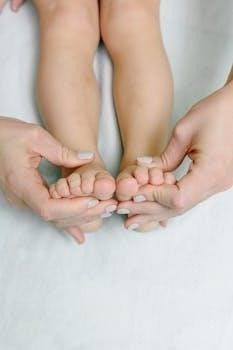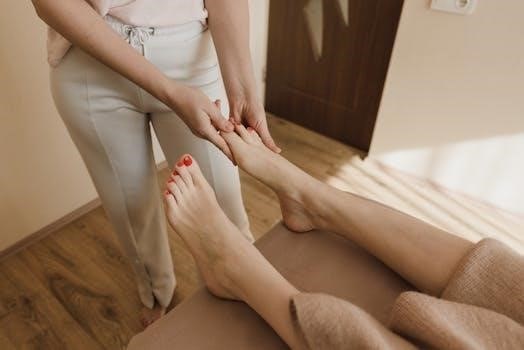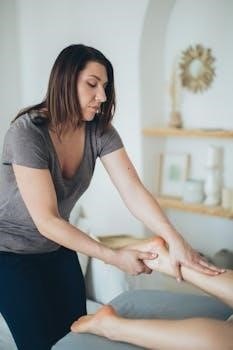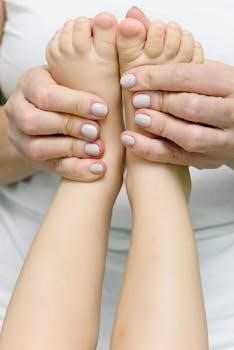What is Foot Massage?
Foot massage is a therapeutic practice that involves applying pressure to specific points on the feet to promote relaxation, improve circulation, and alleviate various ailments. It’s more than just a luxury!

Benefits of Foot Massage
Foot massage offers numerous benefits, including stress reduction, improved blood circulation, pain relief, and enhanced mental well-being; Regular foot massages can also help prevent foot-related ailments and promote overall wellness!
Promotes Relaxation and Stress Reduction
Foot massage is a powerful tool for promoting relaxation and reducing stress. The gentle pressure and manipulation of the feet can release tension throughout the body, leading to a profound sense of calm and rejuvenation. Many people find that incorporating regular foot massages into their routine helps them manage daily stress more effectively. The act of focusing on the feet and the sensations experienced during the massage can also serve as a form of mindfulness, allowing you to disconnect from racing thoughts and ground yourself in the present moment. This can be particularly beneficial after a long and demanding day, providing a welcome respite from the pressures of work and other responsibilities. Furthermore, the release of endorphins during a foot massage can contribute to an overall feeling of well-being and contentment, helping to alleviate feelings of anxiety and improve mood. Whether you choose to receive a foot massage from a professional or practice self-massage techniques at home, the benefits for relaxation and stress reduction are undeniable. The simple act of caring for your feet can have a significant impact on your overall mental and emotional state, promoting a greater sense of balance and tranquility in your life. So, take some time to pamper your feet and experience the transformative power of foot massage for yourself. You deserve it!
Improves Blood Circulation
Foot massage plays a vital role in enhancing blood circulation, particularly in the lower extremities. Many individuals spend a significant portion of their day sitting, which can impede blood flow to the feet and legs. This reduced circulation can lead to various issues, including fatigue, swelling, and even more serious complications over time. Foot massage helps to counteract these effects by stimulating the muscles and tissues in the feet, encouraging blood to flow more freely. The pressure applied during the massage helps to dilate blood vessels, allowing for increased oxygen and nutrient delivery to the cells. This improved circulation not only revitalizes the feet but also has a positive impact on overall health. For individuals with conditions that contribute to poor circulation, such as diabetes or peripheral artery disease, regular foot massage can be particularly beneficial. By promoting healthy blood flow, foot massage can help to nourish tissues, reduce inflammation, and support the body’s natural healing processes. Moreover, improved circulation can contribute to increased energy levels and a greater sense of well-being. Whether you opt for a professional massage or practice self-massage techniques, incorporating foot massage into your routine is a simple yet effective way to boost circulation and maintain healthy feet. The warmth generated during the massage further enhances blood flow, providing relief from stiffness and discomfort. So, take the time to care for your feet and experience the invigorating effects of improved circulation through regular foot massage. Your feet will thank you!
Relieves Pain and Alleviates Ailments
Foot massage is a highly effective method for relieving pain and alleviating various ailments affecting the feet and body. The targeted pressure and manipulation of tissues during a foot massage can help to release tension, reduce inflammation, and promote healing. One of the most common foot-related ailments that can be addressed with massage is plantar fasciitis. This condition, characterized by pain in the heel and arch of the foot, can be significantly improved through regular massage that targets the plantar fascia ligament. By loosening the tight tissues and improving blood flow to the area, foot massage can alleviate pain and promote flexibility. Additionally, foot massage can provide relief from other foot problems such as bunions, flat feet, and general stiffness. The increased circulation and muscle relaxation can help to improve mobility and reduce discomfort. Beyond foot-specific ailments, foot massage can also have a positive impact on overall pain management. The stimulation of pressure points on the feet can trigger the release of endorphins, which are natural pain relievers. This can help to reduce pain associated with headaches, back pain, and even digestive issues. Furthermore, foot massage can promote relaxation and reduce stress, which can indirectly contribute to pain relief. By calming the nervous system and reducing muscle tension throughout the body, foot massage can create a sense of well-being and reduce the perception of pain. Whether you are seeking relief from a specific foot ailment or simply looking to manage general pain and discomfort, incorporating foot massage into your routine can be a valuable tool. The combination of targeted pressure, increased circulation, and relaxation makes foot massage a powerful and natural way to alleviate pain and improve overall health.
Improves Mental Health and Sleep Aid
Foot massage offers significant benefits for both mental health and sleep quality. The act of receiving a foot massage can be incredibly soothing, helping to reduce stress, anxiety, and promote a sense of calm. The gentle pressure and manipulation of the feet can stimulate the release of endorphins, which are natural mood boosters that can help to alleviate feelings of depression and improve overall well-being. In addition to its direct impact on mood, foot massage can also help to reduce stress hormones like cortisol. By lowering cortisol levels, foot massage can help to promote relaxation and reduce feelings of overwhelm. This can be particularly beneficial for individuals who struggle with chronic stress or anxiety. Furthermore, foot massage can improve mental clarity and focus. By reducing stress and tension, foot massage can help to clear the mind and improve concentration. This can be especially helpful for individuals who work in demanding jobs or who struggle with mental fatigue. The benefits of foot massage extend beyond mental health to also include improvements in sleep quality. Many people find that receiving a foot massage before bed can help them to fall asleep more easily and sleep more soundly throughout the night. The relaxation induced by the massage can help to calm the nervous system and reduce racing thoughts, making it easier to drift off to sleep. Additionally, foot massage can help to relieve muscle tension and discomfort, which can often interfere with sleep. By relaxing the muscles in the feet and legs, foot massage can create a sense of physical comfort that promotes restful sleep. Whether you are struggling with stress, anxiety, depression, or insomnia, incorporating foot massage into your routine can be a valuable tool for improving your mental health and sleep quality. The combination of relaxation, endorphin release, and muscle tension relief makes foot massage a natural and effective way to promote overall well-being and restful sleep.

Basic Foot Massage Techniques
Mastering a few basic techniques can unlock the many benefits of foot massage. These techniques include applying pressure, kneading muscles, and using various hand movements to stimulate blood flow and relieve tension in the feet.
Rubbing and Kneading
Rubbing and kneading are fundamental techniques in foot massage, designed to warm the muscles, improve circulation, and release tension. Rubbing involves using long, gliding strokes along the foot, from the toes to the ankle, with varying degrees of pressure. This helps to increase blood flow to the area, promoting healing and reducing stiffness. Kneading, on the other hand, is a more focused technique that involves using your fingers and thumbs to gently squeeze and manipulate the muscles of the foot. This helps to break up knots and adhesions, relieving pain and improving flexibility. When performing these techniques, it’s important to use a massage oil or lotion to reduce friction and allow your hands to glide smoothly over the skin. Start with light pressure and gradually increase it as the muscles relax. Pay attention to any areas of tenderness or tension and spend extra time working on those spots. Remember to communicate with the person receiving the massage to ensure that the pressure is comfortable and effective. Incorporating both rubbing and kneading into your foot massage routine can provide a comprehensive and therapeutic experience, leaving the feet feeling refreshed and rejuvenated. Regular application of these techniques can also help to prevent foot-related ailments such as plantar fasciitis and bunions by promoting better circulation and flexibility in the feet.
Pressing and Tapping
Pressing and tapping are vital techniques in foot massage, complementing rubbing and kneading to stimulate specific pressure points and invigorate the feet. Pressing involves applying firm, sustained pressure to particular areas of the foot, often corresponding to reflexology points that are believed to connect to different organs and systems in the body. By applying pressure to these points, you can help to relieve pain, reduce stress, and promote overall well-being. Tapping, also known as percussion, is a lighter, more rhythmic technique that involves using your fingertips or the sides of your hands to gently tap on the soles and tops of the feet. This helps to stimulate the nerves and muscles, increasing circulation and energy flow. When performing pressing, it’s important to use your thumbs or fingertips to apply steady, even pressure, holding each point for a few seconds before releasing. Be mindful of the person’s comfort level and adjust the pressure accordingly. For tapping, use a light, brisk motion, covering the entire foot with a rhythmic pattern. Pressing and tapping can be particularly beneficial for relieving headaches, digestive issues, and other ailments, as well as for promoting relaxation and reducing fatigue. Incorporating these techniques into your foot massage routine can provide a comprehensive and therapeutic experience, leaving the feet feeling revitalized and energized. Remember to combine pressing and tapping with rubbing and kneading for a well-rounded massage that addresses all aspects of foot health and wellness. Regular practice can contribute to healthier feet, improved circulation, and a greater sense of overall well-being.

Self Foot Massage Techniques
Self-foot massage is a convenient and effective way to relieve tired, achy feet and promote overall well-being without relying on someone else. It’s a practice you can easily incorporate into your daily routine, offering numerous benefits such as improved circulation, reduced stress, and relief from pain and discomfort. To begin, find a comfortable seated position where you can easily reach your feet. You can sit on a chair, couch, or even on the floor with your legs extended. Start by applying a massage oil or lotion to your hands to help them glide smoothly over your feet. Begin with gentle strokes, warming up the muscles and tissues. Use your thumbs to make small, circular motions all over the soles of your feet, paying particular attention to areas that feel tense or sore. You can also use your knuckles to apply deeper pressure to these areas. Next, move on to the tops of your feet, using your fingers to massage the muscles between the bones. Don’t forget to massage your toes, gently pulling and twisting each one to release tension. For a more targeted approach, try using your thumb to apply pressure to specific reflexology points on your feet. Refer to a reflexology chart to identify the points that correspond to different organs and systems in your body. Hold each point for a few seconds, breathing deeply and allowing the tension to release. You can also use a tennis ball or golf ball to massage your feet. Simply place the ball under your foot and roll it back and forth, applying pressure as needed. This can be particularly effective for relieving plantar fasciitis and other foot pain. Aim to spend at least 10-15 minutes massaging each foot, focusing on areas that need the most attention. Remember to listen to your body and adjust the pressure accordingly. With regular practice, self-foot massage can become a valuable tool for maintaining foot health and promoting overall well-being. It’s a simple yet powerful way to relax, rejuvenate, and take care of your feet from the comfort of your own home.

Tools for Foot Massage
While a skilled pair of hands can work wonders, various tools can enhance and complement the foot massage experience, offering unique benefits and targeting specific areas. These tools range from simple and affordable to more advanced and technologically sophisticated, catering to different needs and preferences. One of the most basic and versatile tools is a massage ball, such as a tennis ball or golf ball. These balls are excellent for self-massage, allowing you to apply targeted pressure to specific points on the soles of your feet. Simply place the ball under your foot and roll it back and forth, adjusting the pressure as needed. This is particularly effective for relieving plantar fasciitis and other foot pain. Another popular tool is a foot roller, which typically consists of a textured roller that you roll your feet over. Foot rollers can help to stimulate circulation, reduce muscle tension, and relieve pain and discomfort. Some foot rollers also have acupressure points that target specific reflexology zones. For a more luxurious experience, consider investing in an electric foot massager. These massagers come in various shapes and sizes, offering a range of features such as vibration, heat, and shiatsu massage. Electric foot massagers can provide deep tissue massage, helping to relax muscles, improve circulation, and relieve stress. Some models also have adjustable settings, allowing you to customize the massage to your preferences. In addition to these tools, you can also use simple household items to enhance your foot massage. For example, a warm towel can be used to soften the skin and relax the muscles before a massage. A basin of warm water with Epsom salts can also be used to soak your feet, further promoting relaxation and reducing inflammation. When choosing tools for foot massage, consider your individual needs and preferences. Do you prefer a gentle massage or a deep tissue massage? Are you looking for a tool to target specific areas, or do you want a more general massage? With so many options available, you’re sure to find the perfect tools to help you achieve optimal foot health and relaxation.

No Responses